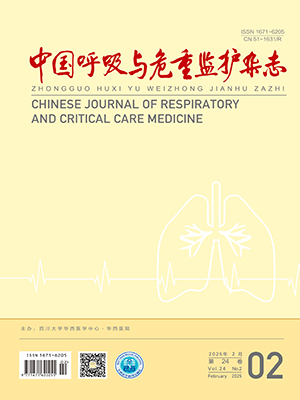| 1. |
Brun-Buisson C, Minelli C, Bertolini G, et al.Epidemiology and outcome of acute lung injury in European intensive care units:results from the ALIVE study.Intensive Care Med, 2004, 30:51-61.
|
| 2. |
Gawlak G, Tian Y, O'Donnell JJ 3rd, et al.Paxillin mediates stretch-induced Rho signaling and endothelial permeability via assembly of paxillin-p42/44MAPK-GEF-H1 complex.FASEB J, 2014, 28:3249-3260.
|
| 3. |
Attar MA, Donn SM.Mechanisms of ventilator-induced lung injury in premature infants.Semin Neonatal, 2002, 7:353-360.
|
| 4. |
Uhlig S.Ventilation-induced lung injury and mechanotransduction:stretching it too far? Am J Physiol Lung Cell Mol Physiol, 2002, 282:L892-L896.
|
| 5. |
Dudek SM, Garcia JG.Cytoskeletal regulation of pulmonary vascular permeability.Appl Physiol, 2001, 91:1487-1500.
|
| 6. |
Mehta D, Malik AB.Signaling mechanisms regulating endothelial permeability.Physiol Rev, 2006, 86:279-367.
|
| 7. |
Brown MC, Turner CE.Paxillin:adapting to change.Physiol Rev, 2004, 84:1315-1339.
|
| 8. |
Quintel M, Heine M, Hirschl RB, et al.Effects of partial liquid ventilation on lung injury in a model of acute respiratory failure:a histologic and morphometric analysis.Crit Care Med, 1998, 26:833-843.
|
| 9. |
Nicholas E, Vlahakis NE, Hubmayr RD.Cellular stress failure in ventilator-injured lungs.Am J Respir Crit Care Med, 2005, 171:1328-1342.
|
| 10. |
Gajic O, Lee J, Doerr CH, et al.Ventilator induced cell wounding and repair in the intact lung.Am J Respir Crit Care Med, 2003, 167:1057-1063.
|
| 11. |
Birukova AA, Chatchavalvanich S, Rios A, et al.Differential regulation of pulmonary endothelial monolayer integrity by varying degrees of cyclic stretch.Am J Pathol, 2006, 168:1749-1761.
|
| 12. |
Shikata Y, Birukov KG, Birukova AA, et al.Involvement of site-specific FAK phosphorylation in sphingosine-1 phosphate and thrombin-induced focal adhesion remodeling:role of Src and GIT.FASEB J, 2003, 17:2240-2249.
|
| 13. |
Petit V, Boyer B, Lentz D, et al.Phosphorylation of tyrosine residues 31 and 118 on paxillin regulates cell migration through an association with CRK in NBT-Ⅱcells.J Cell Biol, 2000, 148:957-970.
|
| 14. |
Geiger B, Bershadsky A.Assembly and mechanosensory function of focal contacts.Curr Opin Cell Biol, 2001, 13:584-592.
|
| 15. |
Orr AW, Helmke BP, Blackman BR, et al.Mechanisms of mechanotransduction.Dev Cell, 2006, 10:11-20.
|
| 16. |
Schwartz MA, Desimone DW.Cell adhesion receptors in mechanotransduction.Curr Opin Cell Biol, 2008, 20:551-556.
|
| 17. |
Nonas S, Birukova AA, Fu P, et al.Oxidized phospholipids reduce ventilator-induced vascular leak and inflammation in vivo.Crit Care, 2008, 12:R27.
|




